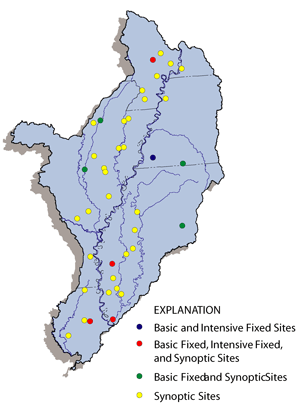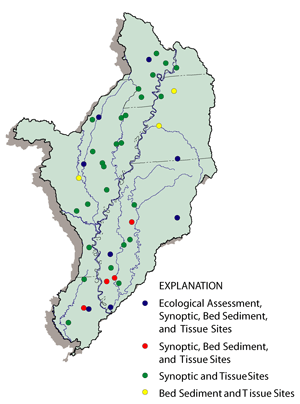STUDY UNIT DESIGN
| Stream Chemistry The stream-chemistry network was designed to measure the effects of land use (primarily cropland) on stream quality and to integrate the effects of multiple land uses and hydrogeologic settings on water quality. Data from the Basic Fixed Sites were used to examine differences in water quality from one basin to another. Data from Intensive Fixed Sites, which were sampled more often, were used to examine seasonal changes in stream quality and to calculate fluxes from the basin. Also, detailed data on pesticides dissolved in the water were collected at intensive sites. A synoptic study was conducted to measure a selected set of constituents at 38 sites in the Study Unit in order to better understand spatial differences among the basins and to compare water chemistry to biological and landscape parameters.
|
 |
 |
Stream Ecology Ecological assessments were done annually at the basic and intensive stream-chemistry sites. The objective of these studies was to investigate biological, chemical, and physical data as multiple lines of evidence to assess water quality. Some of the assessments examined multiple reaches of a stream to determine spatial variations in the community structure of the aquatic organisms. Synoptic studies were designed to examine spatial variability in biological communities in the Study Unit and to relate this variability to stream chemistry and landscape variables. Early in the project, bed sediment and fish tissue were sampled at a subset of sites; later in the project, fish tissue was sampled for organochlorine concentrations at all of the synoptic sites.
|
| Ground-Water Chemistry Three surveys examined the effects of land use on ground water in different aquifer settings. The deep Tertiary aquifers are the deepest aquifers studied and the ones that provide drinking water to the greatest number of people in the Study Unit. The Memphis shallow aquifer survey was designed to assess the ground-water quality in commercial and residential areas. The alluvial aquifer survey examined ground-water quality from a shallow aquifer that is heavily used for agriculture. |
 |
| SUMMARY OF DATA COLLECTION IN THE MISSISSIPPI EMBAYMENT STUDY UNIT, 1995-98 |
||||
|---|---|---|---|---|
| Study component |
What data were collected and why |
Types of sites sampled |
Number of sites |
Sampling frequency and period |
| Stream Chemistry |
||||
| Basic Fixed Sites |
Continuous streamflow, nutrients, major ions, organic carbon, suspended sediment, and physical parameters were measured to describe concentrations and seasonal variations. |
Sites were selected to represent the range of ecoregions, physiographic regions, and land uses present in the Study Unit. |
9 |
Samples were collected monthly February 1996 - January 1998. |
| Intensive Fixed Sites |
In addition to the above list of data collected at the Basic Fixed Sites, information on 82 dissolved pesticides was collected to determine concentrations, seasonal variations, and loads. Volatile organic compounds also were measured at the urban site. |
Three of the sites were located at streams that drained intensive agricultural areas but were dominated by different crop types. One site was a large river site with mixed land use. The remaining site was located in a rapidly growing urban area. |
5 |
Sampling frequency ranged from biweekly during the growing season to weekly throughout the remainder of the period February 1996 - January 1998. |
| Synoptic Sites-- Water Chemistry |
Nutrients, pesticides, and physical properties were measured to broaden the spatial coverage of water-quality information in the Study Unit. |
Synoptic sites were selected in an effort to sample streams that drained all major crop types grown in the Study Unit. |
38 |
Samples were collected once during May, July, and August 1997. |
| Stream Ecology |
||||
| Ecological Assessment Sites |
Fish, macroinvertebrate, algae, and habitat data were collected to examine relations among the biological community and water chemistry, land use, and physical components of the landscape and drainage basin. |
Sites were selected to represent the range of ecoregions, physiographic regions, and land uses present in the Study Unit.
|
8 |
Samples were collected once during low-flow conditions in the summers of 1996-98; at two sites, three reaches were sampled in 1996. |
| Synoptic Sites-- Ecology |
Fish, macroinvertebrate, habitat, and streamflow data were collected once at a larger number of sites to develop a better understanding of the spatial aspects of aquatic communities in the Study Unit. |
Synoptic sites were selected in an effort to sample streams that drained all major crop types grown in the Study Unit.
|
38 |
Samples were collected July-September 1997 for macroinvertebrates; July- September 1998 for fish. |
| Contaminants in Bed Sediments |
Total PCB's, organochlorine pesticides, semivolatile organic compounds, and trace elements were measured in order to determine the occurrence and distribution of contaminants in stream sediments. |
Sites were selected to represent the range of ecoregions, physiographic regions, and land uses present in the Study Unit.
|
15 |
Samples were collected during August and September 1995. |
| Contaminants in Fish Tissue |
Organochlorine pesticides were measured in whole fish, and trace elements were measured in fish liver. |
Sites were selected in an effort to sample streams that drained all major crop types grown in the Study Unit.
|
41 (pesticides) 15 (trace elements) |
Samples were collected during late summer low- flow conditions in 1995-98. |
| Ground-Water Chemistry |
||||
| Deep Tertiary Aquifers |
Nutrients, major ions, pesticides, volatile organic compounds, radioisotopes, stable isotopes, and physical parameters were measured to determine overall water quality in a deep aquifer used for drinking water. |
Public-supply wells screened in the deep Tertiary aquifers (Claiborne and Wilcox Groups) were sampled. |
30 |
Samples were collected once during April and May 1996. |
| Memphis Shallow Aquifers |
Nutrients, major ions, trace elements, pesticides, volatile organic compounds, radioisotopes, stable isotopes, and physical parameters were measured to determine overall water quality in shallow aquifers in a rapidly developing urban area.
|
Twenty-four monitoring wells screened in the shallow water-table aquifer and eight monitoring wells screened in the upper part of the Memphis aquifer were sampled. |
32 |
Samples were collected once during April and May 1997. |
| Alluvial Aquifer |
Nutrients, major ions, trace elements, pesticides, volatile organic compounds, radioisotopes, stable isotopes, and physical parameters were measured to determine overall water quality in an aquifer largely used for agricultural irrigation, but also for public supply and industry. |
Twenty-five irrigation wells screened in the Holocene alluvium and 29 irrigation wells screened in the Pleistocene valley trains were sampled. |
54 |
Samples were collected once during the summer of 1998. |
| Special Studies |
||||
| Pesticides in the Atmosphere |
Pesticides were measured in the air and in the rain. |
Two sites were sampled-one in an agricultural area in Sharkey County, Miss., and one in an urban area in Jackson, Miss. |
2 |
Samples were collected April-September 1995. |
| Pesticides in Fish Tissue in the Mississippi River |
Organochlorine pesticides in whole fish (common carp) were measured to determine if pesticides leaving the Yazoo River Basin could be detected in fish in the Mississippi River. |
Four sites were selected within an area 100 miles upstream and another four sites were selected 100 miles downstream from the confluence of the Yazoo River and the Mississippi River. |
8 |
Samples were collected once during November 1997. |
| Table of Contents || Previous Section || Next Section || Glossary U.S. Geological Survey Circular 1208 Suggested citation:
|

